[English] 日本語
 Yorodumi
Yorodumi- PDB-8j6z: Cryo-EM structure of the Arabidopsis thaliana photosystem I(PSI-L... -
+ Open data
Open data
- Basic information
Basic information
| Entry | Database: PDB / ID: 8j6z | ||||||
|---|---|---|---|---|---|---|---|
| Title | Cryo-EM structure of the Arabidopsis thaliana photosystem I(PSI-LHCII-ST2) | ||||||
 Components Components |
| ||||||
 Keywords Keywords | PHOTOSYNTHESIS / photosystem I / PSI / CELL CYCLE | ||||||
| Function / homology |  Function and homology information Function and homology informationresponse to desiccation / cellular response to abscisic acid stimulus / response to red light / photosynthesis, light harvesting in photosystem II / photosynthetic NADP+ reduction / photosystem I stabilization / chloroplast photosystem I / PSII associated light-harvesting complex II / chloroplast stromal thylakoid / response to low light intensity stimulus ...response to desiccation / cellular response to abscisic acid stimulus / response to red light / photosynthesis, light harvesting in photosystem II / photosynthetic NADP+ reduction / photosystem I stabilization / chloroplast photosystem I / PSII associated light-harvesting complex II / chloroplast stromal thylakoid / response to low light intensity stimulus / chloroplast membrane / regulation of stomatal closure / response to far red light / response to high light intensity / chloroplast thylakoid / plastoglobule / photosynthesis, light harvesting in photosystem I / apoplast / photosystem I reaction center / response to fructose / photosystem I / thylakoid / chloroplast envelope / photosystem I / photosynthetic electron transport chain / photosystem II / positive regulation of reactive oxygen species biosynthetic process / plastid / chlorophyll binding / photosynthetic electron transport in photosystem I / chloroplast thylakoid membrane / response to light stimulus / photosynthesis / response to cold / chloroplast / 4 iron, 4 sulfur cluster binding / oxidoreductase activity / electron transfer activity / protein stabilization / protein domain specific binding / mRNA binding / magnesium ion binding / mitochondrion / extracellular region / nucleus / metal ion binding / plasma membrane / cytosol Similarity search - Function | ||||||
| Biological species |  | ||||||
| Method | ELECTRON MICROSCOPY / single particle reconstruction / cryo EM / Resolution: 2.79 Å | ||||||
 Authors Authors | Chen, S.J.B. / Wu, J.H. / Sui, S.F. / Zhang, L.X. | ||||||
| Funding support |  China, 1items China, 1items
| ||||||
 Citation Citation |  Journal: Mol Plant / Year: 2023 Journal: Mol Plant / Year: 2023Title: Regulatory dynamics of the higher-plant PSI-LHCI supercomplex during state transitions. Authors: Jianghao Wu / Shuaijiabin Chen / Chao Wang / Weijun Lin / Chao Huang / Chengxu Fan / Dexian Han / Dandan Lu / Xiumei Xu / SenFang Sui / Lixin Zhang /  Abstract: State transition is a fundamental light acclimation mechanism of photosynthetic organisms in response to the environmental light conditions. This process rebalances the excitation energy between ...State transition is a fundamental light acclimation mechanism of photosynthetic organisms in response to the environmental light conditions. This process rebalances the excitation energy between photosystem I (PSI) and photosystem II through regulated reversible binding of the light-harvesting complex II (LHCII) to PSI. However, the structural reorganization of PSI-LHCI, the dynamic binding of LHCII, and the regulatory mechanisms underlying state transitions are less understood in higher plants. In this study, using cryoelectron microscopy we resolved the structures of PSI-LHCI in both state 1 (PSI-LHCI-ST1) and state 2 (PSI-LHCI-LHCII-ST2) from Arabidopsis thaliana. Combined genetic and functional analyses revealed novel contacts between Lhcb1 and PsaK that further enhanced the binding of the LHCII trimer to the PSI core with the known interactions between phosphorylated Lhcb2 and the PsaL/PsaH/PsaO subunits. Specifically, PsaO was absent in the PSI-LHCI-ST1 supercomplex but present in the PSI-LHCI-LHCII-ST2 supercomplex, in which the PsaL/PsaK/PsaA subunits undergo several conformational changes to strengthen the binding of PsaO in ST2. Furthermore, the PSI-LHCI module adopts a more compact configuration with shorter Mg-to-Mg distances between the chlorophylls, which may enhance the energy transfer efficiency from the peripheral antenna to the PSI core in ST2. Collectively, our work provides novel structural and functional insights into the mechanisms of light acclimation during state transitions in higher plants. | ||||||
| History |
|
- Structure visualization
Structure visualization
| Structure viewer | Molecule:  Molmil Molmil Jmol/JSmol Jmol/JSmol |
|---|
- Downloads & links
Downloads & links
- Download
Download
| PDBx/mmCIF format |  8j6z.cif.gz 8j6z.cif.gz | 1.1 MB | Display |  PDBx/mmCIF format PDBx/mmCIF format |
|---|---|---|---|---|
| PDB format |  pdb8j6z.ent.gz pdb8j6z.ent.gz | 964.3 KB | Display |  PDB format PDB format |
| PDBx/mmJSON format |  8j6z.json.gz 8j6z.json.gz | Tree view |  PDBx/mmJSON format PDBx/mmJSON format | |
| Others |  Other downloads Other downloads |
-Validation report
| Summary document |  8j6z_validation.pdf.gz 8j6z_validation.pdf.gz | 13.3 MB | Display |  wwPDB validaton report wwPDB validaton report |
|---|---|---|---|---|
| Full document |  8j6z_full_validation.pdf.gz 8j6z_full_validation.pdf.gz | 13.9 MB | Display | |
| Data in XML |  8j6z_validation.xml.gz 8j6z_validation.xml.gz | 210.2 KB | Display | |
| Data in CIF |  8j6z_validation.cif.gz 8j6z_validation.cif.gz | 261.9 KB | Display | |
| Arichive directory |  https://data.pdbj.org/pub/pdb/validation_reports/j6/8j6z https://data.pdbj.org/pub/pdb/validation_reports/j6/8j6z ftp://data.pdbj.org/pub/pdb/validation_reports/j6/8j6z ftp://data.pdbj.org/pub/pdb/validation_reports/j6/8j6z | HTTPS FTP |
-Related structure data
| Related structure data |  36021MC 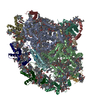 8j7aC 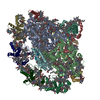 8j7bC M: map data used to model this data C: citing same article ( |
|---|---|
| Similar structure data | Similarity search - Function & homology  F&H Search F&H Search |
- Links
Links
- Assembly
Assembly
| Deposited unit | 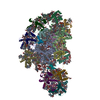
|
|---|---|
| 1 |
|
- Components
Components
-Chlorophyll a-b binding protein ... , 4 types, 5 molecules 14xyz
| #1: Protein | Mass: 26021.895 Da / Num. of mol.: 1 Source method: isolated from a genetically manipulated source Source: (gene. exp.)   | ||
|---|---|---|---|
| #4: Protein | Mass: 27760.461 Da / Num. of mol.: 1 Source method: isolated from a genetically manipulated source Source: (gene. exp.)   | ||
| #18: Protein | Mass: 28250.984 Da / Num. of mol.: 2 Source method: isolated from a genetically manipulated source Source: (gene. exp.)   #19: Protein | | Mass: 28753.369 Da / Num. of mol.: 1 Source method: isolated from a genetically manipulated source Source: (gene. exp.)   |
-Photosystem I ... , 15 types, 15 molecules 23ABCDEFGHIJKLO
| #2: Protein | Mass: 27782.814 Da / Num. of mol.: 1 Source method: isolated from a genetically manipulated source Source: (gene. exp.)   |
|---|---|
| #3: Protein | Mass: 29206.311 Da / Num. of mol.: 1 Source method: isolated from a genetically manipulated source Source: (gene. exp.)   |
| #5: Protein | Mass: 83315.367 Da / Num. of mol.: 1 Source method: isolated from a genetically manipulated source Source: (gene. exp.)   |
| #6: Protein | Mass: 82555.883 Da / Num. of mol.: 1 Source method: isolated from a genetically manipulated source Source: (gene. exp.)   |
| #7: Protein | Mass: 9049.509 Da / Num. of mol.: 1 Source method: isolated from a genetically manipulated source Source: (gene. exp.)   |
| #8: Protein | Mass: 22336.598 Da / Num. of mol.: 1 Source method: isolated from a genetically manipulated source Source: (gene. exp.)   |
| #9: Protein | Mass: 14984.955 Da / Num. of mol.: 1 Source method: isolated from a genetically manipulated source Source: (gene. exp.)   |
| #10: Protein | Mass: 24203.125 Da / Num. of mol.: 1 Source method: isolated from a genetically manipulated source Source: (gene. exp.)   |
| #11: Protein | Mass: 17103.271 Da / Num. of mol.: 1 Source method: isolated from a genetically manipulated source Source: (gene. exp.)   |
| #12: Protein | Mass: 15291.522 Da / Num. of mol.: 1 Source method: isolated from a genetically manipulated source Source: (gene. exp.)   |
| #13: Protein/peptide | Mass: 4137.024 Da / Num. of mol.: 1 Source method: isolated from a genetically manipulated source Source: (gene. exp.)   |
| #14: Protein/peptide | Mass: 5011.897 Da / Num. of mol.: 1 Source method: isolated from a genetically manipulated source Source: (gene. exp.)   |
| #15: Protein | Mass: 13219.431 Da / Num. of mol.: 1 Source method: isolated from a genetically manipulated source Source: (gene. exp.)   |
| #16: Protein | Mass: 23070.557 Da / Num. of mol.: 1 Source method: isolated from a genetically manipulated source Source: (gene. exp.)   |
| #17: Protein | Mass: 15156.470 Da / Num. of mol.: 1 Source method: isolated from a genetically manipulated source Source: (gene. exp.)   |
-Sugars , 1 types, 1 molecules 
| #30: Sugar | ChemComp-DGD / |
|---|
-Non-polymers , 11 types, 262 molecules 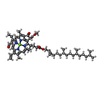

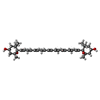

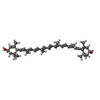


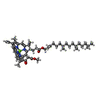

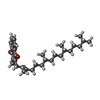
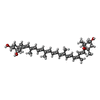










| #20: Chemical | ChemComp-CHL / #21: Chemical | ChemComp-CLA / #22: Chemical | ChemComp-XAT / ( #23: Chemical | ChemComp-LHG / #24: Chemical | ChemComp-LUT / ( #25: Chemical | ChemComp-BCR / #26: Chemical | #27: Chemical | ChemComp-CL0 / | #28: Chemical | #29: Chemical | #31: Chemical | |
|---|
-Details
| Has ligand of interest | Y |
|---|
-Experimental details
-Experiment
| Experiment | Method: ELECTRON MICROSCOPY |
|---|---|
| EM experiment | Aggregation state: PARTICLE / 3D reconstruction method: single particle reconstruction |
- Sample preparation
Sample preparation
| Component | Name: photosystem I / Type: COMPLEX / Entity ID: #1-#19 / Source: NATURAL |
|---|---|
| Source (natural) | Organism:  |
| Buffer solution | pH: 7.4 |
| Specimen | Embedding applied: NO / Shadowing applied: NO / Staining applied: NO / Vitrification applied: YES |
| Vitrification | Cryogen name: ETHANE |
- Electron microscopy imaging
Electron microscopy imaging
| Experimental equipment |  Model: Titan Krios / Image courtesy: FEI Company |
|---|---|
| Microscopy | Model: FEI TITAN KRIOS |
| Electron gun | Electron source:  FIELD EMISSION GUN / Accelerating voltage: 300 kV / Illumination mode: OTHER FIELD EMISSION GUN / Accelerating voltage: 300 kV / Illumination mode: OTHER |
| Electron lens | Mode: OTHER / Nominal defocus max: 2200 nm / Nominal defocus min: 1200 nm |
| Image recording | Electron dose: 50.5 e/Å2 / Film or detector model: GATAN K3 (6k x 4k) |
- Processing
Processing
| EM software | Name: PHENIX / Version: 1.20.1_4487: / Category: model refinement | ||||||||||||||||||||||||
|---|---|---|---|---|---|---|---|---|---|---|---|---|---|---|---|---|---|---|---|---|---|---|---|---|---|
| CTF correction | Type: PHASE FLIPPING AND AMPLITUDE CORRECTION | ||||||||||||||||||||||||
| 3D reconstruction | Resolution: 2.79 Å / Resolution method: FSC 0.143 CUT-OFF / Num. of particles: 188490 / Symmetry type: POINT | ||||||||||||||||||||||||
| Refine LS restraints |
|
 Movie
Movie Controller
Controller











 PDBj
PDBj





















